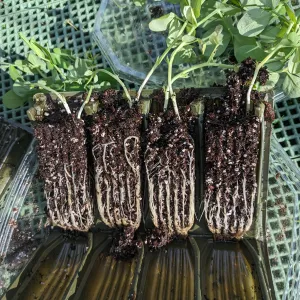Blog article by Nanelle Jones-Sullivan

In early October, I went to a wonderful Master Gardener class about growing Sweet Peas.
I have grown sweet peas before, but this year I am determined to be more intentional, use what I learned to have a longer, better season. This year, I will be choosing seeds most likely to be successful in my Sunset Zone 8/9 garden. The Zone 8/9 Sweet peas are photoperiodic; they bloom based on day length. Early flowering types are sometimes called “winter flowering” or “spring flowering”. They flower with as few as 10 or 11 hours of day length respectively, rather than with the 12 hours needed for the more common Spencers that bloom in May. I’ve seen them sold as part of a series such as Winter Sunshine, Spring Sunshine, Winter Elegance, and Solstice. Our day length first crosses the 11-hour mark on February 19, 2025, for flowering before Vacaville’s 80’s and 90’s set in.

Starting in October, sweet peas take six to eight weeks from seeding to flowering. They germinate better in warmer temperatures than they grow. In cooler temperatures, they will grow stocky and not need pinching. “Two Sisters Flower Farm” says 50-55 degrees Fahrenheit for germination, 35-50 degrees Fahrenheit to put on growth. 45-68 degrees Fahrenheit for flowering.
"No soaking!" Marryn Mathis in “Sweet Pea School” writes, neither sweet pea expert Roger Parsons nor respected New Zealand plant breeder Dr. Keith Hammett recommends soaking sweet pea seeds; in fact, both advise against it.
Starting my seed in seed trays rather than sowing directly, hopefully avoiding slugs, snails, birds, and not enough or too much water. Seed starters with individual cells allow each plant to have its own space to grow, and the roots do not become entangled. Sweet peas have big and long root systems with a big and long taproot that grows deep, making it difficult to transplant. “Root Trainer” seed trays are over four inches deep, with grooved sides that encourage the roots to grow straight down, and open like a book to release the seedling when it's time to transplant. Air holes at the bottom mean the roots stop growing when they get outside the pot, a process called “air-pruning”.

Planting out the right number of plants in the right container. I will be transplanting to their forever home in Earth Box self-watering containers. They are on wheels, so I can move to shade in the spring. Each container holds 14 pea seedlings and has six-foot trellis attachments.
References
Sweet Pea School by Marryn Mathis
Early blooming sweet peas at Sweet Pea Gardens

